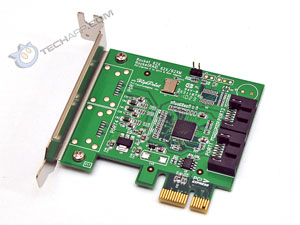The 3 TB Hard Disk Drive Installation Guide
When news first leaked about the imminent launch of the Western Digital Caviar Green 3 TB hard disk drive, it got a ton of people really excited. Everyone has been fervently awaiting the arrival of the first desktop hard disk drive to break the 2.1 TB limit that has virtually halted the growth of hard disk drive capacity for last 2 years.
Although Seagate was the first to ship a 3 TB hard disk drive in an external drive - the Seagate FreeAgent GoFlex Desk, Western Digital would be the first to ship 2.5 and 3 TB internal hard disk drives that anyone can pop into their desktop PCs. However, Western Digital had to rely on a workaround to get the new drives to work with current motherboads, resulting in some limitations :
-
Every Western Digital Caviar Green 2.5 TB and 3 TB hard disk drive will ship with an AHCI-compliant SATA controller card that runs off the PCI Express x1 bus. Currently, that's the HighPoint RocketRAID 620.
-
When used with the proper driver, the PCI Express SATA controller card will allow you to make use of the 2.5 TB and 3 TB hard disk drives as secondary drives.
-
You will only be able to use them as boot drives with 64-bit versions of Windows Vista and Windows 7 if your motherboard supports UEFI. They will also boot on Mac OS 10.5 Leopard (or better) and Linux.
-
The 2.5 TB and 3 TB hard disk drives will need to be formatted using GPT (GUID Partition Table), so only operating systems that support GPT (e.g. Windows Vista, Windows 7) will be able to support the new hard disk drives. Windows XP only supports MBR, so it won't be able to support the new drives.
Hardware Installation
 |
The hardware installation part is pretty straightforward. The HighPoint RocketRAID 620 is a PCI Express x1 card, so all you have to do is insert it into any PCI Express x1 slot in your motherboard. However, if you do not have enough spare PCI Express x1 slots, you can use any of the larger PCI Express slots, e.g. PCI Express x4 or even a PCI Express x16 slot. They will all work just fine.
Next, install the 3 TB (or 2.5 TB) hard disk drive as you would any other hard disk drive - insert the drive into a 3.5" bay and screw into place. Then, attach the SATA power and data cables. The other end of the SATA data cable should, of course, be attached to any one of the two available SATA ports on the HighPoint RocketRAID 620 SATA controller card.
That's it! Simple enough, isn't it?
Setting Up In Windows 7
Installing the Western Digital Caviar Green 3 TB hard disk drive in Microsoft Windows 7 was a piece of cake. It installs and works just like any other SATA hard disk drive.
When you first boot up, Windows 7 will detect the new hard disk drive and SATA controller and install the necessary drivers. Then it's just a simple matter of going to the Disk Management console (Control Panel -> Administrative Tools -> Computer Management -> Disk Management) and partitioning the drive as you wish. Windows 7 will automatically set the drive to use the GUID Partition Table (GPT).
If you have experience setting up hard disk drives, you will have no problem partitioning and formatting this hard disk drive. That's the good news. The bad news is it's not so simple in Windows Vista. Let's take a look.
Important : Microsoft Windows 7 users should install the KB2249857 update, which prevents "disk corruption when hibernating, or crashing using a disk drive that is greater than or equal to two terabytes". The problem doesn't affect all users of 2 TB or larger hard disk drives, but why take the risk?
Support Tech ARP!
If you like our work, you can help support out work by visiting our sponsors, participate in the Tech ARP Forums, or even donate to our fund. Any help you can render is greatly appreciated!
Page |
Topic |
||
1 |
• Introduction |
||
2 |







 Add to Reddit
Add to Reddit
